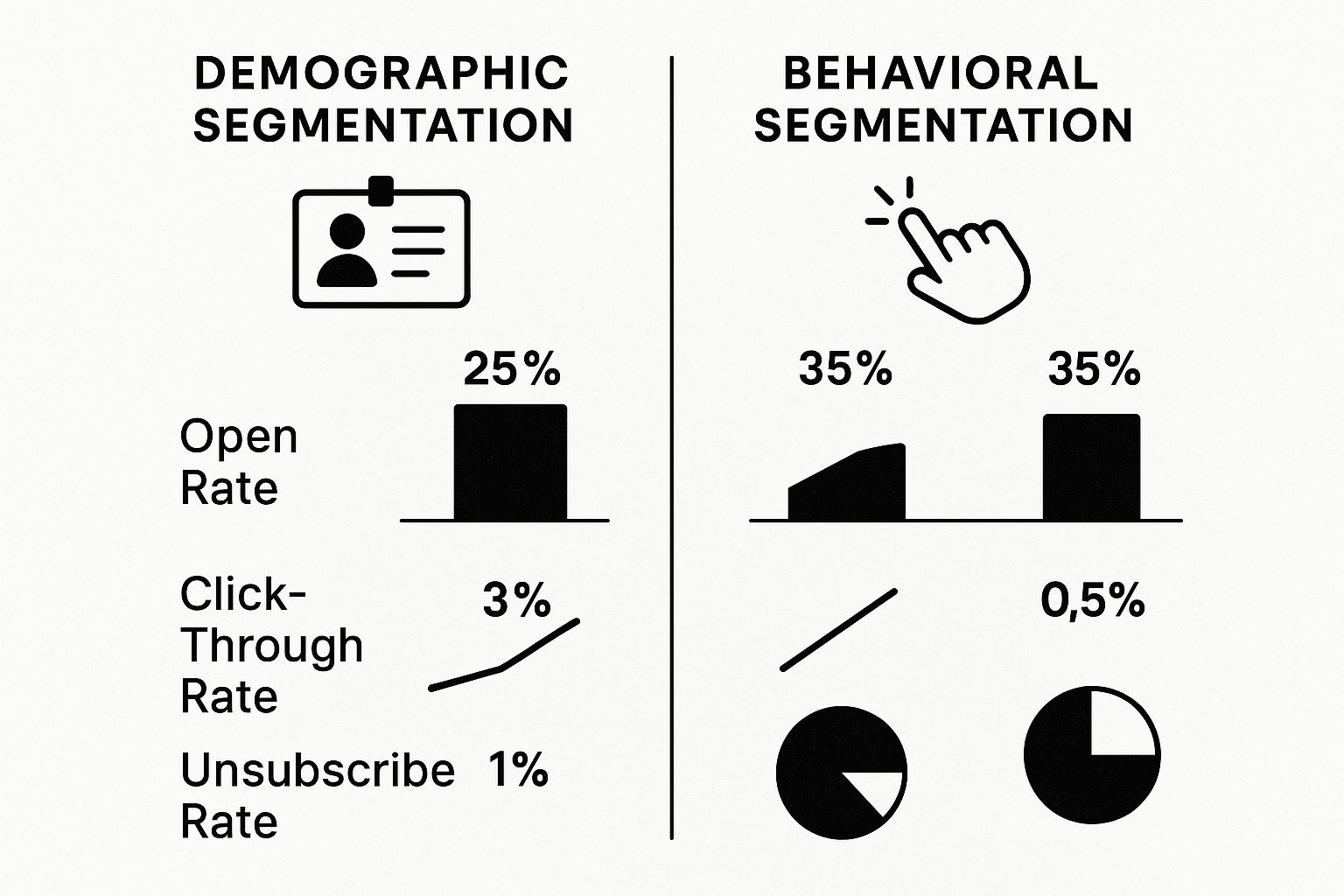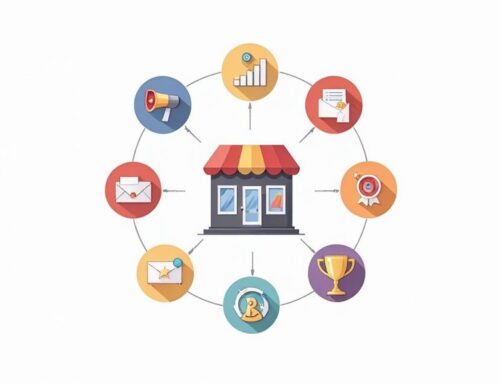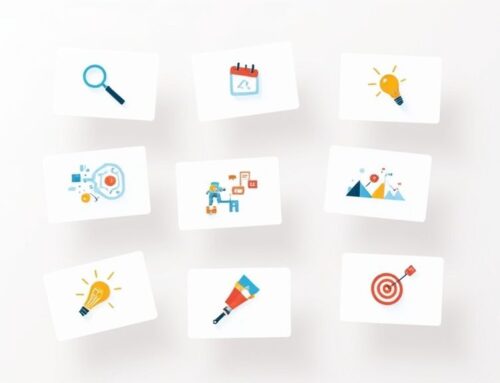Building an email list really boils down to a simple value exchange. You offer something genuinely useful—like an exclusive guide or a first-time discount—and in return, a visitor gives you their email address.
Why an Email List Is Your Most Powerful Marketing Tool
Before we jump into the nuts and bolts of how to build an email list, it’s crucial to understand why this channel is still such an unbeatable asset. Think about it: social media platforms can tweak their algorithms on a whim, and your reach can plummet overnight. Your email list, on the other hand, is a direct line to your audience that you completely own and control.
These are people who have actively raised their hands and said, “Yes, I want to hear from you.” That’s a powerful position to be in. Instead of shouting into the void of a chaotic social feed, you’re an invited guest in their personal inbox. This is where you can build real, lasting relationships.
The Value of an Owned Audience
Owning your audience means you’re not building your business on rented land. If a social network folds or its policies change, your connection to the people who follow you can vanish instantly. An email list is a stable, reliable asset that only becomes more valuable as it grows.
This stability has a direct impact on your bottom line. In fact, well-executed email marketing can drive an incredible 760% increase in revenue. This isn’t just about blasting out weekly newsletters. It’s about carefully nurturing potential customers and guiding them on a journey with your brand.
It’s no surprise that 89% of marketers rely on email as their primary channel for generating leads. This isn’t a fleeting trend; it’s a cornerstone of a healthy business. You can dive deeper into these email marketing statistics to see just how critical it is for growth.
An email subscriber isn’t just another contact. They are a warm lead who has given you permission to speak with them directly. In digital marketing, that permission is pure gold.
A Preview of What’s to Come
This guide won’t just give you vague advice like “create great content.” My goal is to show you exactly how to build a high-performing, list-building machine from the ground up. We’ll concentrate on actionable strategies that attract the right kind of subscribers—people who are genuinely invested in what you have to say.
So, what are we going to cover?
Here’s a quick look at the primary methods we’ll explore for capturing emails and nurturing leads throughout this guide.
Core Email List Building Strategies
| Strategy | Primary Goal | Where to Use |
|---|---|---|
| Laying the Groundwork | Set up the right tools and define your ideal subscriber to ensure all efforts are targeted and effective. | Before you launch any campaigns; foundational setup. |
| Crafting Irresistible Incentives | Create high-value lead magnets that solve a real problem, making people eager to subscribe. | Landing pages, blog posts, homepage, exit-intent popups. |
| Strategic Form Placement | Place signup forms in high-visibility areas to maximize conversions without disrupting the user experience. | Website header/footer, sidebar, within content, popups. |
| Driving Targeted Traffic | Use SEO, social media, and paid ads to bring a steady stream of potential subscribers to your site. | Blog content, social media profiles, targeted ad campaigns. |
As you can see, we’re taking a holistic approach. We’ll move step-by-step from foundational planning to advanced growth tactics, giving you everything you need to build a list that truly works for your business.
Laying the Groundwork for a Thriving Email List

It’s tempting to jump straight into collecting emails, but the most powerful lists are built on a solid foundation, not on hasty tactics. I’ve seen countless people make the mistake of skipping this initial setup, and it almost always leads to weak engagement and a ton of wasted effort down the road.
Before you can even think about getting your first subscriber, you need a proper system to manage your contacts and send your campaigns. This is where an Email Service Provider (ESP) is absolutely essential. Trying to run an email list from your personal Gmail or Outlook is a recipe for disaster—it’s incredibly inefficient and can get you in hot water with anti-spam laws.
An ESP is your command center. It handles everything from the signup forms and subscriber organization to campaign analytics and legal compliance. Choosing the right one is a critical first step.
Choosing the Right Email Service Provider
With so many ESPs out there, picking one can feel a bit overwhelming. The secret is to find a platform that fits your current needs, budget, and where you see yourself in a year or two. Think about how easy it is to use, what kind of automation it offers, and whether it plays nice with the other tools you already rely on.
To give you a better idea, here’s a quick comparison of two popular platforms I often recommend for different situations:
| Feature | Mailchimp | ConvertKit |
|---|---|---|
| Best For | Beginners and small businesses looking for an all-in-one tool that’s easy to get the hang of. | Creators, bloggers, and anyone who needs powerful segmentation and automation. |
| Key Strength | Its simplicity is its biggest selling point. The generous free plan lets you get started without any financial risk. | Incredible “if-this-then-that” automation rules that allow you to create deeply personalized journeys for your subscribers. |
| Pricing Model | Tiered pricing based on subscriber numbers and features. The free plan is great but has its limits. | Mostly based on subscriber count, with nearly all key features included even on lower-tier paid plans. |
Mailchimp is a fantastic starting point for many. But as your list grows, you might find the more sophisticated tools in a service like ConvertKit are exactly what you need to nurture your audience effectively. Don’t get stuck in analysis paralysis here. Just pick one that makes sense for you right now—you can always migrate later if you need to.
Define Your Ideal Subscriber
With your tools ready, it’s time to ask the most important question of all: Who are you actually trying to reach?
If your answer is “everyone,” you’re setting yourself up to connect with no one. This is why creating an ideal subscriber persona isn’t just a nice-to-have; it’s a non-negotiable part of the process.
A subscriber persona is a fictional, detailed profile of the exact person you want on your list. This isn’t just about demographics. It dives deep into their goals, what keeps them up at night, and what truly motivates them. When you know this, you can craft offers and content that feel like they were written just for them.
Think about it this way. A financial advisor isn’t just targeting “people with money.” A much better target is “millennial couples planning to buy their first home who feel completely overwhelmed by the mortgage process.” That second description instantly sparks ideas for valuable content they would eagerly sign up for.
Nailing these profiles is a game-changer. For a great, step-by-step guide on this, check out this walkthrough on how to create buyer personas. It will help you pinpoint exactly who your ideal audience is.
Understand the Legal Essentials
Finally, let’s talk about the boring but crucial stuff: legal compliance. Building your list must be done on a foundation of trust and respect for privacy laws like GDPR in Europe or the CAN-SPAM Act in the U.S. Ignoring these rules can lead to massive fines and, just as importantly, destroy your brand’s reputation.
Here are the absolute must-dos:
- Get Explicit Consent: Never, ever add someone to your email list without their clear permission. That means no pre-checked boxes on your forms. They need to actively opt-in.
- Make Opting-Out Easy: Every single email you send must have a clear, one-click unsubscribe link. No exceptions.
- Identify Yourself Clearly: Your emails must state who they are from and include a valid physical mailing address.
Following these rules isn’t just about staying out of trouble. It’s about building a quality list of people who actually want to hear from you. That respect is what leads to a highly engaged audience and, ultimately, much better results for your business.
Creating Lead Magnets People Genuinely Want

Let’s be honest—people are protective of their inboxes. A tired, generic “subscribe to our newsletter” just doesn’t cut it anymore. To earn that coveted spot, you need to offer something so valuable that handing over an email address feels like a no-brainer.
This is exactly what a great lead magnet does. It’s an irresistible resource offered in exchange for an email, turning a transactional moment into the start of a real relationship. Your goal isn’t just to get an email; it’s to attract a genuinely interested person by solving one of their immediate problems.
Moving Beyond Basic Checklists
A simple PDF guide can still work, but to really stand out, you need to think bigger. The most effective lead magnets today offer a deeper level of engagement or a more tangible solution. Don’t just give them a static document; give them a tool that helps them achieve a quick, meaningful win.
The magic happens when your lead magnet perfectly aligns with your visitor’s needs and connects to your long-term business goals. This isn’t about giving away freebies for the sake of it. You’re offering a powerful preview of the value your brand delivers every single day.
A great lead magnet makes someone think, “If their free stuff is this good, I can only imagine what their paid services are like.” It sets the bar high and frames the subscription as the start of something truly valuable.
High-Impact Lead Magnet Ideas
So, what kind of lead magnets actually move the needle? It really depends on your audience and what they’re trying to accomplish. The key is matching the format to their specific problem.
Here are a few powerful ideas that go way beyond a simple download.
1. Interactive Diagnostic Quizzes
People love to learn about themselves. A quiz that helps diagnose a problem and offers personalized feedback in return is an absolute powerhouse for collecting qualified leads. A user answers a few quick questions and, in exchange for their email, gets a custom report or action plan.
- For example: A marketing agency could build a “What’s Your Biggest Marketing Bottleneck?” quiz. Based on the answers, the results could point the person toward specific blog posts or services tailored to their biggest challenge, like SEO or content creation.
- Best For: Consultants, service-based businesses, and anyone in health, wellness, or finance.
2. Practical Templates and Swipe Files
Why just tell someone how to do something when you can give them a shortcut? Templates—whether for project plans, social media graphics, or email outreach—offer immediate, tangible value. You’re literally saving your audience time and mental energy.
- For example: A business coach could offer a “Client Onboarding Template Pack” that includes a proposal template, a welcome email script, and an invoice template. This solves a common, and often frustrating, professional headache instantly.
- Best For: B2B companies, solopreneurs, and any professional audience that lives and dies by efficiency.
3. Exclusive Video Workshops or Mini-Courses
Video has a much higher perceived value than text alone. Offering a free video workshop or a short email-based mini-course immediately positions you as an expert. It’s also a fantastic way to connect with your audience on a more personal, face-to-face level.
- For example: A fitness coach could create a “5-Day Core Strength Challenge” delivered through daily emails, each with a short video tutorial. This format helps build a daily habit and gives people a real taste of their coaching style.
- Best For: Educators, coaches, creators, and brands that have a visual product or process to show off.
Aligning Your Offer with Your Audience
The most successful lead magnets feel like they were made just for the person downloading them. Think back to that ideal subscriber persona you worked on. What’s a nagging problem you can solve for them right now? If your ideal customer struggles with lead generation, a generic “marketing tips” PDF is noise. A targeted offer, on the other hand, is a signal.
Putting together the right offer is a cornerstone of any solid marketing plan. For more ideas on attracting the right people, our guide on small business lead generation has strategies that pair perfectly with a compelling lead magnet.
Here’s a quick brainstorming table to get the ideas flowing:
| Industry/Niche | Common Problem | Lead Magnet Idea |
|---|---|---|
| E-commerce (Skincare) | “I have no idea what my skin type is or which products to use.” | A “Personalized Skincare Routine” quiz. |
| Real Estate | “I’m totally overwhelmed by the home-buying process.” | A “First-Time Home Buyer’s Checklist & Budget Planner.” |
| SaaS (Project Management) | “My team’s projects are always disorganized and behind schedule.” | A free “Ultimate Project Kickoff Template” for a tool like Asana or Trello. |
Ultimately, here’s the acid test: the best lead magnet is one that you would genuinely be willing to pay for. When you approach it with that mindset, you’ll stop just collecting emails and start building a loyal list of fans who can’t wait to hear from you.
Placing Signup Forms for Maximum Conversions

You could have the world’s best lead magnet, but if nobody sees the offer, it’s useless. That’s where smart signup form placement comes in. The whole idea is to make subscribing feel like a natural, easy next step right when a visitor is most interested in what you have to say.
It’s a bit of a balancing act. You need to be visible enough to get noticed but not so loud that you annoy people and disrupt their experience. The trick is to weave subscription opportunities into the natural flow of your website, turning key moments of interest into conversion hotspots. This is one of the most important lessons when you’re figuring out how to build an email list that actually grows.
High-Visibility, Low-Intrusion Locations
Before we get into the clever, dynamic stuff, let’s nail the basics. These are the tried-and-true spots that should be on pretty much every website. Think of them as your reliable, always-on conversion points.
- Website Header/Navigation: A simple “Subscribe” or “Get My Free Guide” link in your main navigation bar is a fantastic, non-pushy way to be ever-present. It’s there for anyone who’s motivated and ready.
- Website Footer: The footer is prime real estate. Visitors who scroll all the way down are clearly engaged and often looking for ways to connect further. A simple, embedded signup form here is a no-brainer.
- Blog Sidebar: If your blog has a classic layout, the sidebar is a go-to spot for a signup form. Just make sure it’s visually clean and clearly communicates why they should subscribe.
These static locations are your safety net. They guarantee that no matter where someone is on your site, there’s always a clear path to joining your list.
Dynamic and Contextual Form Placement
To really put your list growth into high gear, you need to show up when a user’s interest is peaking. This means going beyond static forms and using ones that react to what your visitors are doing.
One of the most effective ways to do this is with an inline signup form. Instead of being pushed off to the side, this form is embedded right inside your content. Picture someone reading your article on “call to actions for Instagram Reels.” Halfway through, you can present an inline form offering a free PDF with “3 Killer CTA Templates for Reels.” The offer is perfectly matched to their immediate interest. It just makes sense.
Another powerhouse is the exit-intent pop-up. This form only appears when a user’s cursor zips up toward the browser’s back button, signaling they’re about to leave. When done right, it doesn’t interrupt their reading. Instead, it’s one last-ditch effort to offer something valuable before they bounce for good.
Think of form placement as a conversation. An inline form is like asking a relevant question mid-sentence, while an exit-intent pop-up is like saying, “Wait, before you go, did you see this?”
Dedicated Landing Pages for Campaigns
While embedded forms are great for capturing your existing site traffic, you absolutely need dedicated landing pages for converting traffic from specific campaigns—like a social media ad or a link from a guest post.
A landing page, sometimes called a “squeeze page,” has one job and one job only: get the signup. There’s no navigation, no sidebar, no distractions. The entire page is built around your lead magnet, selling its benefits and funneling the user directly to the form. This intense focus is why landing pages almost always convert better for campaign traffic.
Don’t forget what happens next, either. That first email is critical. Welcome emails—the very first message a new subscriber gets—have a stunning average open rate of 51%. This just proves how engaged people are in that initial moment. Considering that nearly 92% of online adults use email, building your list with well-placed forms is a direct line to an audience that’s ready and waiting to hear from you. You can discover more about how audiences engage with email marketing and what it means for your broader strategy.
Driving Quality Traffic to Your Opt-In Forms
Okay, you’ve done the hard work. You’ve created a fantastic lead magnet and placed your opt-in forms in all the right spots. But a great offer is useless if no one sees it. The next move is all about getting the right eyeballs on those forms.
This isn’t about just blasting your site with any old traffic. We’re talking about attracting a steady stream of people who are genuinely interested in what you have. The goal is to find high-quality prospects who won’t just sign up, but will become engaged, long-term subscribers. The trick is to meet people where they already are, whether they’re searching for answers on Google or scrolling through their favorite social media app.
Use SEO to Attract Motivated Searchers
Search Engine Optimization (SEO) is, without a doubt, the most powerful long-term play for building your email list. It’s a slow burn, but the payoff is huge. Think about it: when someone types “how to create an email list” into Google, they’re not just browsing—they’re actively looking for a solution. They have a problem, and they want it solved now.
This is where your content becomes a list-building machine. Imagine you have a blog post titled “3 Killer CTA Ideas for Instagram Reels.” You can embed a relevant freebie right in the middle of it, like a PDF download of “My Top 5 High-Converting CTA Templates.” The person reading your post is already in the right mindset, and you’re offering them an immediate, valuable tool. It’s a natural next step for them to hand over their email address.
The beauty of this strategy lies in user intent. They found you because they had a specific need, and your lead magnet offers the perfect solution at the perfect time. This alignment is what makes SEO-driven traffic so incredibly valuable for building a high-quality list.
Promote Your Lead Magnets on Social Media
While SEO is fantastic for capturing people with active intent, social media helps you connect with potential subscribers where they hang out and relax. The key here is to stop treating your social profiles like a broadcast channel and start seeing them as gateways to your email list.
Your bio link is prime real estate. Don’t just link to your homepage! Use a “link in bio” tool to put your best lead magnet front and center. A simple, direct call to action like “Grab my free project kickoff template” is way more compelling than a generic “Visit my website.”
Here are a few other ways I’ve seen this work really well:
- Dedicated Posts & Stories: Create eye-catching posts and stories that scream the main benefit of your lead magnet. Use great visuals and a crystal-clear call to action.
- Pin It: Pin a post promoting your best lead magnet to the top of your Facebook page or X (formerly Twitter) profile. It’s the first thing any new visitor will see.
- Talk About It: Mention your free resources naturally in your videos on TikTok or Instagram Reels. Just a simple, “Hey, if you want the template I’m using, the link is in my bio” can work wonders.
The idea is to constantly and consistently remind your social audience that you have valuable stuff waiting for them. This approach is how you turn passive followers into active, excited email subscribers.
Run Focused Paid Ad Campaigns
Want faster, more predictable growth? Paid advertising is your best friend. Platforms like Facebook, Instagram, and Google Ads let you run hyper-targeted campaigns that funnel people directly to a landing page (often called a “squeeze page”) built specifically for your lead magnet.
The real power of paid ads is their precision. You can target people based on their interests, online behaviors, and demographics, which means your offer only gets in front of those most likely to care.
A well-designed ad campaign doesn’t just drive clicks; it drives the right clicks. By sending people to a clean, distraction-free landing page focused solely on the signup, you can skyrocket your conversion rates.
This is also where you can get really smart with segmentation from day one. Run different ads for different audience segments, each promoting a lead magnet tailored to their unique needs. This personalized approach not only gets you more signups but also starts the entire subscriber relationship off on the right foot. To take this even further, you can explore ways to boost your email marketing conversion rates by delivering personalized content from the very beginning.
Don’t just take my word for it. Understanding what drives real engagement is everything. The infographic below shows just how much more effective it is to segment your audience by their behavior (what they do) rather than just their demographics (who they are).

As you can see, subscribers who are grouped based on their actions—like which specific lead magnet they downloaded—are far more likely to open and click on your future emails.
Comparing Traffic Sources for List Building
Choosing the right traffic source depends entirely on your goals, budget, and timeline. Are you playing the long game or do you need subscribers now? Here’s a quick breakdown to help you decide where to focus your energy.
| Traffic Source | Relative Cost | Subscriber Quality | Best For |
|---|---|---|---|
| SEO | Low (Time) | Very High | Building a sustainable, long-term asset with highly motivated subscribers. |
| Social Media | Low-Medium | Good | Engaging a community and turning existing followers into subscribers. |
| Paid Ads | High (Money) | Varies (High if targeted well) | Rapid, predictable growth and scaling your list-building efforts quickly. |
Ultimately, a mix of these channels often works best. You can use paid ads for an initial boost while your SEO efforts gain traction over time.
This focus on quality over quantity has never been more critical. With an estimated 376 billion emails sent every single day to about 4.6 billion email users worldwide, the inbox is a crowded place. Your messages have to be exceptionally relevant to get noticed. By combining organic strategies like SEO with targeted paid campaigns, you create a powerful, well-rounded system for attracting people who will become a true community, not just another number on a list.
Answering Your Top Questions About Building an Email List
As you get your hands dirty with email list building, you’re bound to run into questions. It happens to everyone. Think of this section as a chat with a seasoned pro, where we’ll tackle the common hurdles and sticking points you’ll face along the way.
We’re moving past the textbook definitions and into the real-world stuff—growth rates, the dreaded unsubscribe button, and what a “successful” list actually looks like day-to-day.
How Quickly Should My Email List Grow?
This is easily the most common question I hear, and the honest answer is always the same: it really depends on what you’re putting into it. There isn’t some magic industry benchmark for “good” growth. A better way to look at it is to focus on the consistency of your efforts.
For example, a blogger who just published their first pillar post with a killer checklist might be thrilled to get 50 new subscribers in the first month. On the other hand, a small e-commerce brand running a targeted ad campaign for a 15% off coupon could pull in several hundred new signups in that same period.
The real metric for success isn’t just speed, but sustainable growth. A steady trickle of people who actually want to hear from you is infinitely more valuable than a massive, one-time surge of unengaged contacts.
My Advice: Stop comparing your Day 1 to someone else’s Year 3. Your growth rate is a direct reflection of your traffic and your offer. Focus on building a repeatable system that brings in a few new people every day. Those small, consistent wins are what build incredible momentum over time.
Is Getting Unsubscribes a Bad Thing?
I know, it stings a little every time you see that “unsubscribe” notification. It’s easy to take it personally and wonder what you did wrong. But here’s a little secret: most of the time, unsubscribes are a good thing.
Think of it as self-cleaning. People who aren’t interested in your emails aren’t your customers. They won’t open your messages, click your links, or buy your products. Keeping them on your list just drags down your engagement rates, which can actually hurt your deliverability with providers like Gmail and Outlook.
So when should you worry?
- Look for sudden spikes. If your unsubscribe rate shoots up right after you send a particular email, it’s time to investigate. Did you use a clickbaity subject line? Was the content totally out of left field for your audience?
- Monitor your overall rate. A consistently high unsubscribe rate (generally anything over 0.5%) might signal a bigger problem. It could mean your lead magnet is attracting the wrong crowd, or your ongoing content isn’t delivering on the promise you made.
An unsubscribe simply means your system is working. It’s filtering out the wrong people so you can focus on the right ones.
How Do I Know If My Lead Magnet Is Working?
Seeing signups roll in is a great start, but that’s only half the story. The true measure of a great lead magnet isn’t just that people want it, but that it attracts the right people who stick around.
To get the full picture, you have to look beyond that initial conversion. I always tell people to ask these questions:
- What’s the open rate on your welcome email? If it’s high, you know people are genuinely excited to get what you promised.
- Are they engaging with the next few emails? Do they open your follow-up content, or do they vanish after getting their freebie? This tells you if you’ve attracted a curious audience or just a bunch of freebie-seekers.
- Do these subscribers eventually become customers? This is the ultimate test. Make sure you tag subscribers based on which lead magnet they downloaded. Over time, you’ll see which offers bring in people who actually buy from you.
If you find one lead magnet brings in tons of signups who go cold immediately, don’t be afraid to scrap it and try something new. I’d much rather have a lead magnet that attracts a smaller, highly engaged audience than one that just inflates my subscriber count with duds.
Should I Buy an Email List?
Let me make this crystal clear: no. Seriously, don’t do it. I know it’s tempting, especially when you’re starting from zero and want a quick win. But buying a list is the fastest way to get your domain blacklisted and absolutely tank your brand’s reputation.
Here’s exactly why it’s such a disaster waiting to happen:
- You Have No Permission: These people never opted in to hear from you. Blasting them with emails isn’t just annoying; it’s a violation of anti-spam laws like GDPR and CAN-SPAM, which can come with hefty fines.
- The Quality is Terrible: Purchased lists are notoriously full of old, fake, or dead email addresses. Your bounce rate will go through the roof, signaling to email providers that you’re a spammer.
- You’ll Damage Your Brand: People will mark your emails as spam, and your reputation will take a nosedive. It’s hard to recover from being known as “that brand who sends junk.”
Building a great email list is about earning trust, one subscriber at a time. There are no shortcuts. The slow, steady work of providing value is the only strategy that pays off in the long run.
Ready to build a powerful marketing engine without the guesswork? ReachLabs.ai integrates expert talent with data-driven strategies to create high-performing campaigns that attract the right audience. Let our team of specialists build and manage a system that drives real growth for your brand. Find out more at https://www.reachlabs.ai.





